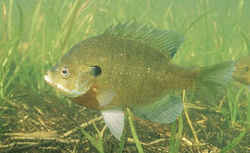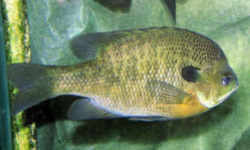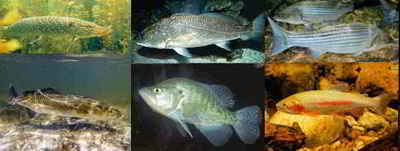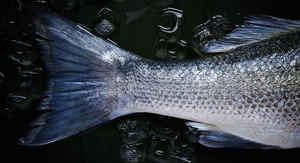Illinois State Fish
Bluegill

(Lepomis macrochirus)
Adopted in 1986.
In 1986, the bluegill, (Lepomis macrochirus,) was selected by school children as Illinois' state fish. Its name comes from the bright blue gill covers found on many males. This species is often called "bream" or "brim" especially in the southern states. These fish are most abundant in clear lakes with lush aquatic vegetation, but bluegills can also be found in a variety of other habitats such as ponds and swamps. A carnivorous fish, bluegills eat primarily aquatic insects and larvae, supplemented by smaller fish, crayfish, snails, and algae. Bluegills grow to about nine inches in length and weigh about twelve ounces.
Illinois State Fish: Bluegill

The bluegill (Lepomis macrochirus) is a species of freshwater fish sometimes referred to as bream, brim, or copper nose. It is a member of the sunfish family Centrarchidae of the order Perciformes. It is native to North America and lives in streams, rivers, lakes, and ponds. It is commonly found east of the Rockies. It usually hides around, and inside, old tree stumps and other underwater structures. It can live in either deep or very shallow water, and will often move back and forth, depending on the time of day or season. Bluegills also like to find shelter among water plants and in the shade of trees along banks.
Characteristic of the Bluegill
The bluegill comes in many varieties and colors. The adult male bluegill is pale blue to greenish-yellow, while the female and young bluegill are grayish-green. Most bluegill are distinguished by six to eight dark vertical bands of color.
When breeding, male bluegill may turn yellow or orange on the throat and body. During this time, the male will build a nest in the sand or gravel at a depth of around 2 feet. The nest is a roundish depression in the ground about twice the size of the male who builds it. Females lay 2,000 to 67,000 eggs each which hatch in five to ten days. During this time the male seldom leaves the nest and guards the area vigorously.
Bluegills are generally carnivorous. Bluegill eat mostly insects like mayflies, damselflies and midges. Larger bluegill may eat freshwater shrimp, small crayfish and snails.
The average lifespan of a bluegill is around 5 to 6 years.
They are generally small to medium-sized fish. The largest one reported from Illinois weighed 1.6 kilograms (3 lb. 8oz.). More typically, one would weigh about 0.3 kilograms (12 oz.) and would be about 24 centimeters (9.5 in.) long. The record catch in Illinois is 3 pounds, 8 ounces, caught in 1987.
Habitat
The bluegill, (Lepomis macrochirus,) is a very common fish throughout the state. It is most abundant in clear lakes with large amounts of aquatic vegetaion. However, it occurs in a large variety of habitats including pools, overflow ponds, oxbows, swamps, and man-made impoundments. They often occur in small loose schools that have up to 20 to 30 individuals in them.
Bluegill continue to be a favorite of those who fish because they are found all over the state and can be caught year-round. Although a child's first catch is often a bluegill, some say these fish put up quite a fight.
Illinois Law
The law designating the Bluegill as the official Illinois state fish is from Section 50 (State fish) of the Illinois Compiled Statutes, Chapter 5 (GENERAL PROVISIONS) Section 460/50
CHAPTER 5 - GENERAL PROVISIONS.
(5 ILCS 460/) State Designations Act.
(5 ILCS 460/50) (from Ch. 1, par. 2901-50)
Sec. 50. State fish. The fish Lepomis macrochirus, commonly known as the "Bluegill", is designated the official State fish of the
State of Illinois.
(Source: P.A. 87-273.)
Taxonomic Hierarchy: Bluegill
Kingdom: Animalia - animals
Phylum: Chordata
Class: Actinopterygii
Order: Perciformes
Family: Centrarchidae
Genus: Lepomis
Species: Lepomis macrochirus








